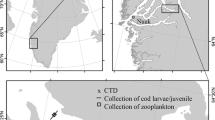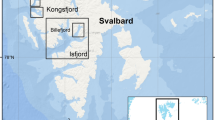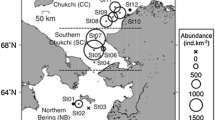Abstract
Distribution of 0-group cod (Gadus morhua) and haddock (Melanogrammus aeglefinus) in August–September 2005 and 2006 was mainly restricted to the Atlantic waters of the western and central areas of the Barents Sea. The main distribution of 0-group fish overlapped largely with areas of high biomass (>7 gm−2 dry weight) of zooplankton. The copepod Calanus finmarchicus and krill Thysanoessa inermis, which are dominant zooplankton species in both Atlantic and boreal waters of the Barents Sea, were the main prey of 0-group cod and haddock. The main distribution, feeding areas and prey of 0-group cod and haddock overlapped, implying that competition for food may occur between the two species. However, though their diet coincided to a certain degree, haddock seems to prefer smaller and less mobile prey, such as Limacina and appendicularians. As 0-group fish increased in size, there seems to be a shift in diet, from small copepods and towards larger prey such as krill and fish. Overall, a largely pelagic feeding behaviour of 0-group cod and haddock was evident from this study.








Similar content being viewed by others
References
Anonymous (2005) Survey report from the Joint Norwegian/Russian ecosystem survey in the Barents Sea August–October 2005, vol 1. IMR/PINRO Joint Report Series, No. 2/2005, pp 1–99
Anonymous (2006) Survey report from the Joint Norwegian/Russian ecosystem survey in the Barents Sea August–October 2006, vol 1. IMR/PINRO Joint Report Series, No. 2/2006, pp 1–97
Anonymous (2007) Survey report from the Joint Norwegian/Russian ecosystem survey in the Barents Sea August–October 2007, vol 1. IMR/PINRO Joint Report Series, No. 4/2007, pp 1–97
Astthorsson OS, Pálsson ÓK (1987) Predation on euphausiids by cod, Gadus morhua, in winter in Icelandic subarctic waters. Mar Biol 96:327–334
Baranova ZP (1972) The feeding of haddock fingerlings in the Southern Barents Sea. ICES CM 1972/F:15, pp 1–6
Beaugrand G, Brander KM, Lindley JA, Souissi S, Reid PC (2003) Plankton effect on cod recruitment in the North Sea. Nature 426:661–664
Bergstad OA, Jørgensen T, Dragesund O (1987) Life history and ecology of the gadoid resources of the Barents Sea. Fish Res 5:119–161
Dalpadado P, Skjoldal HR (1996) Abundance, maturity and growth of the krill species, Thysanoessa inermis and T. longicaudata in the Barents Sea. Mar Ecol Prog Ser 144:175–183
Dingsør GE (2005) Estimating abundance indices from the international 0-group fish survey in the Barents Sea. Fish Res 72:205–218
Dingsør GE, Ciannelli L, Chan KS, Ottersen G, Stenseth NC (2007) Density dependence and density independence during the early life stages of four marine fish stocks. Ecology 88:625–634
Dolgov AV, Yaragina NA, Orlova EL, Bogstad B, Johannessen E, Mehl S (2007) 20th anniversary of the PINRO-IMR cooperation in the investigations of feeding in the Barents Sea—results and perspectives. Proceedings of the 12th Norwegian—Russian Symposium 21–22 August 2007, Tromsø, Norway. IMR/PINRO report series 5/2007, pp 44–78
Einarsson H (1945) Euphausiacea 1. Northern Atlantic species. Dana-Report. Carlsberg Found 27, pp 1–195
Eriksen E, Prozorkevich D, Dingsør GE (2009) An evaluation of 0-group abundance indices of Barents Sea fish stocks. Open Fish Sci J 2:6–14
Falk-Petersen S, Pavlov V, Timofeev S, Sargent JR (2007) Climate variability and possible effects on arctic food chains: the role of Calanus. In: Ørbæk JB, Tombre T, Kallenborn R, Hegseth E, Falk-Petersen S, Hoel AH (eds) Arctic alpine ecosystems and people in a changing environment. Springer, Berlin, pp 147–166
Floeter J, Temming A (2003) Explaining diet composition of North Sea cod (Gadus morhua): prey size preference vs. prey availability. Can J Fish Aquat Sci 60:140–150
Gjøsæter H, Dalpadado P, Hassel A, Skjoldal HR (2000) A comparison of performance of WP2 and MOCNESS. J Plankton Res 22:1901–1908
Gjøsæter H, Dalpadado P, Hassel A (2002) Growth of Barents Sea capelin (Mallotus villosus) in relation to zooplankton abundance. ICES J Mar Sci 59:959–967
Gjøsæter H, Huse G, Robberstad Y, Skogen M (eds) (2008) Havets ressurser og miljø. Fisken og havet, særnummer 1-2008, pp 34–36 (In Norwegian, English summary)
ICES (2008) Report of the arctic fisheries working group, 21–29 April 2008, Copenhagen, Denmark. ICES CM 2008/ACOM:01, pp 1–531
Kwasniewski S, Hop H, Falk-Petersen S, Pedersen G (2003) Distribution of Calanus species in Kongsfjorden, a glacial fjord in Svalbard. J Plankton Res 25:1–20
Lilly GR, Fleming AM (1981) Size relationships in predation by Atlantic cod, Gadus morhua, on capelin, Mallotus villosus, and sand lance, Ammodytes dubius, in the Newfoundland area. NAFO Sci Council Stud 1:41–45
Loeng H (1989) The influence of temperature on some fish population parameters in the Barents Sea. J Northwest Atl Fish Sci 9:103–113
Loeng H (1991) Features of the physical oceanographic conditions of the Barents Sea. Polar Res 10:5–18
Nakken O, Raknes A (1996) Corrections of indices of abundance of 0-group fish in the Barents Sea for varying capture efficiency. ICES C.M. 1996/G:12, pp 1–10
Olseth JA, Skartveit A (1985) Strålingshåndbok. Det norske metereologiske institutt, Oslo, Klima nr. 7, pp 1–57
Orlova EL, Boitsov VD, Dolgov AV, Rudneva GB, Nesterova VN (2005) The relationship between plankton, capelin and cod under different conditions. ICES J Mar Sci 62:1281–1292
Pálsson ÓK (1973) Nahrunguntersuchungen an den Jugendstadien (0-gruppen) einiger Fischarten in isländischen Gewässern. Berichte Deutschen Wissenschaft Kommission Meeresforschung 23, pp 1–32 (in German)
Pedersen T, Fossheim M (2008) Diet of 0-group stages of capelin (Mallotus villosus), herring (Clupea harengus) and cod (Gadus morhua) during spring and summer in the Barents Sea. Mar Biol 153:1037–1046
Ponomarenko IY (1983) Long-term dynamics of bottom-dwelling young cod survival connected with feeding and temperature conditions. ICES CM 1983/L:9, pp 1–17
Robb AP (1981) Observations on the food and diel feeding behaviour of pelagic 0-group gadoids in the northern North Sea. J Fish Biol 18:183–194
Robb AP, Hislop JRG (1980) The food of five gadoids species during the pelagic 0-group phase in the northern North Sea. J Fish Biol 16:199–217
Schoener TW (1970) Nonsynchronous spatial overlap of lizards in patchy habitats. Ecology 51:408–418
Skjoldal HR, Dalpadado P, Dommasnes A (2004) Food webs and trophic interactions. In: Skjoldal HR (ed) The Norwegian Sea ecosystem. Tapir Academic Press, Trondheim, pp 447–506
Sonina MA (1969) Biology of the Arcto—Norwegian haddock during 1937–1965. Fish Res Bd Can Transl Ser 1924:1–151
Stiansen JE, Filin AA (eds) (2008) Joint PINRO/IMR Report on the State of the Barents Sea Ecosystem in 2007, with expected situation and Considerations for management. IMR-PINRO Joint Report Series 2008(1), Institute of Marine Research, Bergen, Norway, p 185
Sundby S, Nakken O (2008) Spatial shifts in spawning habitats of Arcto-Norwegian cod related to multidecadal climate oscillations and climate change. ICES J Mar Sci 65:953–962
Sysoeva TK (1972) Feeding and survival of the Barents Sea haddock and fry. ICES CM 1972/F:16, pp 1–7
Sysoeva TK, Degtereva AA (1965) The relation between the feeding of cod larvae and pelagic fry and the distribution and abundance of their principle food organisms. ICNAF Spec Pub 6:411–416
Tande KS (1991) Calanus in North Norwegian fjords and in the Barents Sea. Polar Res 10:389–407
Wassmann P (2008) Impact of global warming on arctic pelagic ecosystems and processes. In: Duarte CM (ed) Impacts of global warming on polar ecosystems. Fundación BBVA Bilbao, pp 111–139
Zhukova NG, Nesterova VN, Prokopchuk IP, Rudneva GB (2009) Winter distribution of euphausiids (Euphausiacea) in the Barents Sea (2000–2005). Deep-Sea Res II 56. doi:10.1016/j.dsr2.2008.11.007
Acknowledgments
This project was part of the research programme “Ecosystem Barents Sea” at the Institute of Marine Research, Bergen, Norway. We thank Harry Williams, Haakon Hop, Fran Mowbray and one anonymous referee for constructive comments on a previous version of the manuscript.
Author information
Authors and Affiliations
Corresponding author
Rights and permissions
About this article
Cite this article
Dalpadado, P., Bogstad, B., Eriksen, E. et al. Distribution and diet of 0-group cod (Gadus morhua) and haddock (Melanogrammus aeglefinus) in the Barents Sea in relation to food availability and temperature. Polar Biol 32, 1583–1596 (2009). https://doi.org/10.1007/s00300-009-0657-7
Received:
Revised:
Accepted:
Published:
Issue Date:
DOI: https://doi.org/10.1007/s00300-009-0657-7




